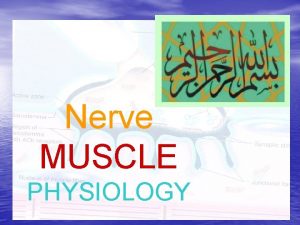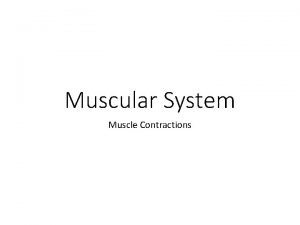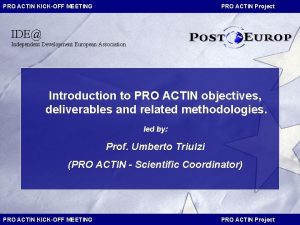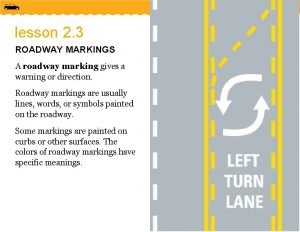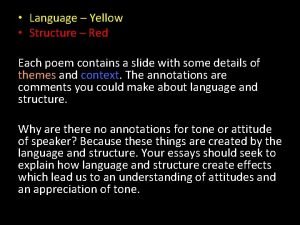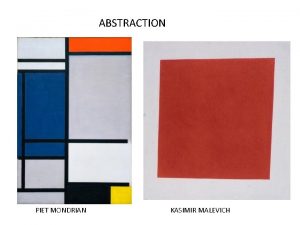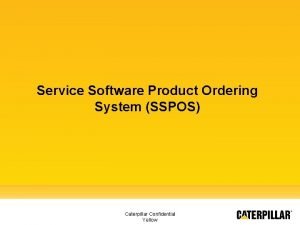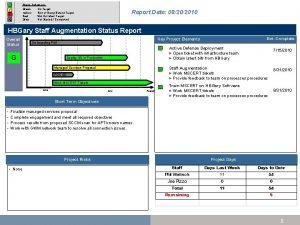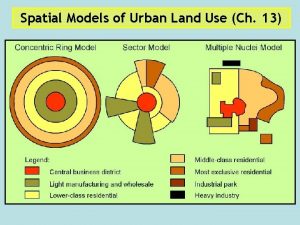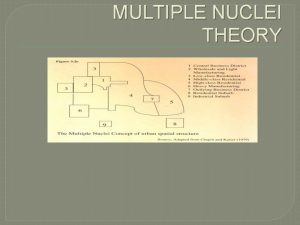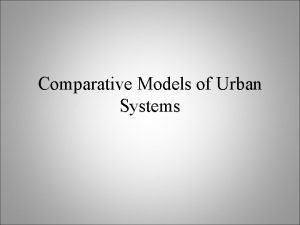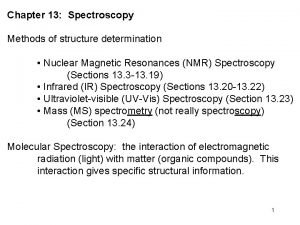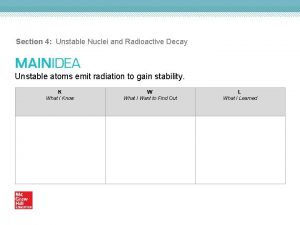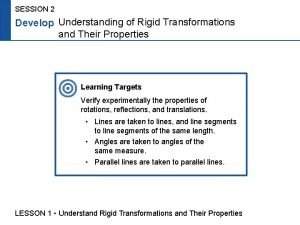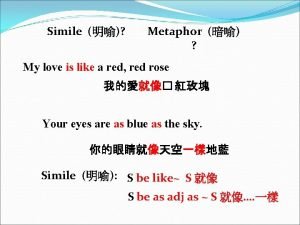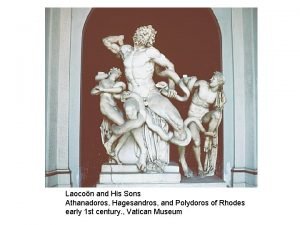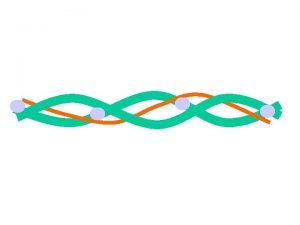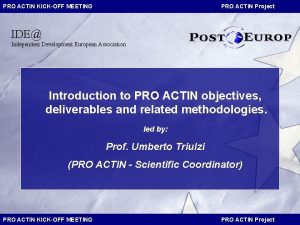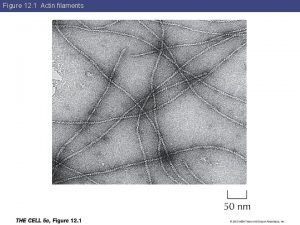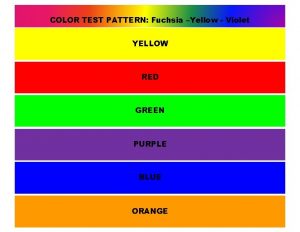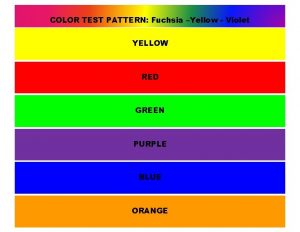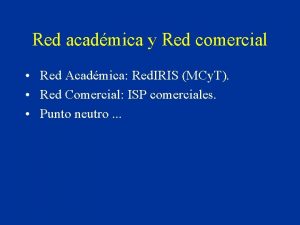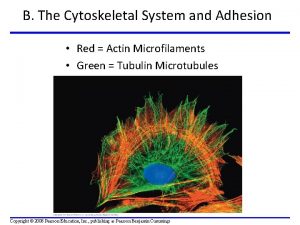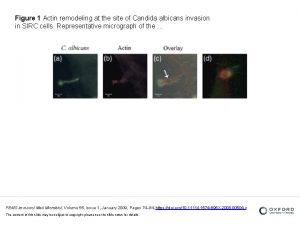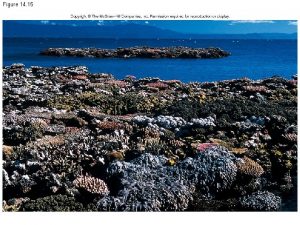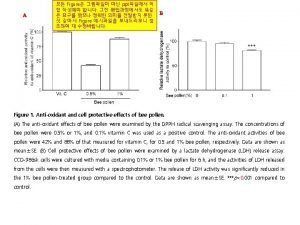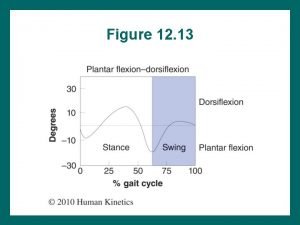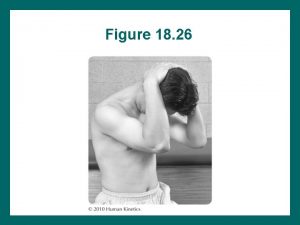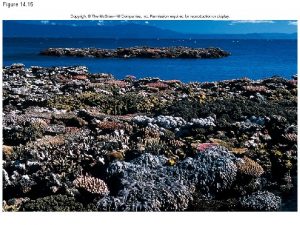Nuclei yellow and actin red Figure 4 6

















































- Slides: 49

• Nuclei (yellow) and actin (red) Figure 4. 6 x Copyright © 2003 Pearson Education, Inc. publishing as Benjamin Cummings

THE CYTOSKELETON The cell’s internal skeleton helps organize its structure and activities • network of protein fibers Figure 4. 17 A Copyright © 2003 Pearson Education, Inc. publishing as Benjamin Cummings

• Microfilaments of actin enable cells to change shape and move • Intermediate filaments reinforce the cell and anchor certain organelles • Microtubules – give the cell rigidity – provide anchors for organelles – act as tracks for organelle movement Copyright © 2003 Pearson Education, Inc. publishing as Benjamin Cummings

Actin subunit Tubulin subunit Fibrous subunits 25 nm 7 nm MICROFILAMENT 10 nm INTERMEDIATE FILAMENT Figure 4. 17 B Copyright © 2003 Pearson Education, Inc. publishing as Benjamin Cummings MICROTUBULE

Copyright © 2003 Pearson Education, Inc. publishing as Benjamin Cummings

How do cilia and flagella move? • A cilia or flagellum is composed of a core of microtubules wrapped in plasma membrane • Eukaryotes have “ 9+2” structure Cilia and flagella move when microtubules bend Copyright © 2003 Pearson Education, Inc. publishing as Benjamin Cummings

FLAGELLUM Electron micrograph of sections: Outer microtubule doublet Plasma membrane Flagellum Central microtubules Outer microtubule doublet Plasma membrane Figure 4. 18 A Copyright © 2003 Pearson Education, Inc. publishing as Benjamin Cummings Basal body (structurally identical to centriole)

Slide 43 Copyright © 2003 Pearson Education, Inc. publishing as Benjamin Cummings

polar head P – hydrophobic molecules nonpolar tails Phospholipid bilayer hydrophilic molecules cytosol

Cell surfaces protect, support, and join cells Surfaces allow exchange of signals and molecules. • Plant cells connect by plasmodesmata Copyright © 2003 Pearson Education, Inc. publishing as Benjamin Cummings

Walls of two adjacent plant cells Vacuole PLASMODESMATA Layers of one plant cell wall Cytoplasm Plasma membrane Figure 4. 19 A Copyright © 2003 Pearson Education, Inc. publishing as Benjamin Cummings

• Animal cells - extracellular matrix – sticky layer of glycoproteins – binds cells together in tissues – can also protect and support cells Copyright © 2003 Pearson Education, Inc. publishing as Benjamin Cummings

• Tight junctions can bind cells together into leakproof sheets • Anchoring junctions link animal cells TIGHT JUNCTION ANCHORING JUNCTION • Gap junctions allow substances to flow from cell to cell GAP JUNCTION Plasma membranes of adjacent cells Figure 4. 19 B Copyright © 2003 Pearson Education, Inc. publishing as Benjamin Cummings Extracellular matrix

Eukaryotic organelles fall into 4 functional groups • 1. Manufacture and transport – dependent on network of membranes - Nucleus - Ribosomes - Rough ER - Smooth ER - Golgi apparatus Copyright © 2003 Pearson Education, Inc. publishing as Benjamin Cummings

2. Breakdown – all single-membrane sacs • Lysosomes (in animals, some protists) • Peroxisomes • Vacuoles (plants) Copyright © 2003 Pearson Education, Inc. publishing as Benjamin Cummings

3. Energy Processing – involves extensive membranes embedded with enzymes • Chloroplasts • Mitochondria Copyright © 2003 Pearson Education, Inc. publishing as Benjamin Cummings

4. Support, Movement, Communication • Cytoskeleton – includes cilia, flagella, filaments, microtubules • Cell walls • Extracellular matrix • Cell junctions Copyright © 2003 Pearson Education, Inc. publishing as Benjamin Cummings


What do these have in common? • • • HIV infection Transplanted organs Communication between neurons Drug addiction Cystic fibrosis hypercholesteremia

Membranes organize the chemical activities of cells • selectively permeable • hold teams of enzymes Cytoplasm Figure 5. 10 Copyright © 2003 Pearson Education, Inc. publishing as Benjamin Cummings

Plasma membrane • Contact between cell and environment • Keeps useful materials inside and harmful stuff outside • Allows transport, communication in both directions

Plasma membrane components § Phospholipid bilayer § Cholesterol § Proteins § Glycocalyx

polar head P – hydrophobic molecules nonpolar tails Phospholipid bilayer hydrophilic molecules cytosol

THE PLASMA MEMBRANE phospholipids cholesterol cytoskeleton peripheral protein integral protein Cholesterol blocks some small molecules, adds fluidity

• Membrane Proteins – span entire membrane or lie on either side – Purposes • Structural Support • Recognition • Communication • Transport

• Glycocalyx – Composed of sugars protruding from lipids and proteins – Functions • Binding sites for proteins • Lubricate cells. • Stick cells down.

• Many membrane proteins are enzymes • Some proteins function as receptors for chemical messages from other cells – The binding of a messenger to a receptor may trigger signal transduction Messenger molecule Receptor Activated molecule Figure 5. 13 Enzyme activity Copyright © 2003 Pearson Education, Inc. publishing as Benjamin Cummings Signal transduction

• The plasma membrane of an animal cell Glycoprotein Carbohydrate (of glycoprotein) Fibers of the extracellular matrix Glycolipid Phospholipid Cholesterol Microfilaments of the cytoskeleton Proteins CYTOPLASM Figure 5. 12 Copyright © 2003 Pearson Education, Inc. publishing as Benjamin Cummings

• Diffusion and Gradients – Diffusion = movement of molecules from region of higher to lower concentration. – Osmosis = diffusion of water across a membrane

• In passive transport, substances diffuse through membranes without work by the cell Molecule of dye Membrane EQUILIBRIUM Figure 5. 14 A & B Copyright © 2003 Pearson Education, Inc. publishing as Benjamin Cummings

(a) selectively permeable membrane H 2 O free water molecule: can fit through pore sugar bound water molecules clustered around sugar: cannot fit through pore (b) selectively permeable membrane sugar molecule water molecule pure water bag bursts

Osmosis = diffusion of water across a membrane • water travels from an area of higher concentration to an area of lower water concentration Hypotonic solution Hypertonic solution Selectively permeable membrane Solute molecule HYPOTONIC SOLUTION HYPERTONIC SOLUTION Water molecule Selectively permeable membrane Solute molecule with cluster of water molecules NET FLOW OF WATER Copyright © 2003 Pearson Education, Inc. publishing as Benjamin Cummings Figure 5. 15

Water balance between cells and their surroundings is crucial to organisms osmoregulation = control of water balance • Osmosis causes cells to shrink in a hypertonic solution and swell in a hypotonic solution Copyright © 2003 Pearson Education, Inc. publishing as Benjamin Cummings

10 microns isotonic solution equal movement of water into and out of cells hypertonic solution net water movement out of cells hypotonic solution net water movement into cells


Passive transport = diffusion across membranes • Small nonpolar molecules - simple diffusion • Many molecules pass through protein pores by facilitated diffusion Solute molecule Figure 5. 17 Transport protein Copyright © 2003 Pearson Education, Inc. publishing as Benjamin Cummings

Active transport • transport proteins needed • against a concentration gradient • requires energy (ATP) Copyright © 2003 Pearson Education, Inc. publishing as Benjamin Cummings

• Active transport in two solutes across a membrane FLUID OUTSIDE CELL Transport protein First solute 1 • Na+/K+ pump Phosphorylated transport protein First solute, inside cell, binds to protein 2 ATP transfers phosphate to protein 3 Protein releases solute outside cell 5 Phosphate detaches from protein 6 Protein releases second solute into cell Second solute • Protein shape change 4 Second solute binds to protein Figure 5. 18 Copyright © 2003 Pearson Education, Inc. publishing as Benjamin Cummings

Exocytosis and endocytosis transport large molecules exocytosis = vesicle fuses with the membrane and expels its contents FLUID OUTSIDE CELL Figure 5. 19 A CYTOPLASM Copyright © 2003 Pearson Education, Inc. publishing as Benjamin Cummings

b

– or the membrane may fold inward, trapping material from the outside (endocytosis) Figure 5. 19 B Copyright © 2003 Pearson Education, Inc. publishing as Benjamin Cummings

Phagocytosis, “cell eating” —How the human immune system ingests whole bacteria or one-celled creatures eat. phagocytosis food particle 1 2 3 particle enclosed in vesicle

Copyright © 2003 Pearson Education, Inc. publishing as Benjamin Cummings

pinocytosis 2 vesicle containing extracellular fluid (cytoplasm)

extracellular fluid plasma membrane cytosol receptors vesicle captured molecules coated pit vesicle bacterium pseudopodium vesicle

Receptor-mediated endocytosis

• Cholesterol can accumulate in the blood if membranes lack cholesterol receptors LDL PARTICLE Phospholipid outer layer Receptor protein Protein Cholesterol Plasma membrane CYTOPLASM Figure 5. 20 Copyright © 2003 Pearson Education, Inc. publishing as Benjamin Cummings Vesicle


What do these have in common? • • • HIV infection Transplanted organs Communication between neurons Drug addiction Cystic fibrosis hypercholesteremia
 Epimysium tendon
Epimysium tendon Smooth muscle myosin
Smooth muscle myosin Myosin and actin
Myosin and actin Proactin
Proactin Red gri
Red gri Red yellow blue purple green pink black white
Red yellow blue purple green pink black white Red orange yellow green
Red orange yellow green What do red raised roadway markers mean
What do red raised roadway markers mean Blue red orange blue green red
Blue red orange blue green red Solid yellow with broken yellow line
Solid yellow with broken yellow line Red green yellow orange blue black white brown pink purple
Red green yellow orange blue black white brown pink purple Red and black flag with yellow circle
Red and black flag with yellow circle Red orange yellow green blue indigo violet
Red orange yellow green blue indigo violet What are the factors of 16
What are the factors of 16 Etymology chart
Etymology chart Still light tunic описание на русском
Still light tunic описание на русском Folklore de lara
Folklore de lara Apotheosis of homer neoclassical or romantic
Apotheosis of homer neoclassical or romantic Piet modriaan
Piet modriaan 77venus shemale
77venus shemale Rotating tires
Rotating tires Literal language-
Literal language- Yellow butter purple jelly
Yellow butter purple jelly Color code white personality
Color code white personality Caterpillar confidential yellow
Caterpillar confidential yellow Red yellow green status definitions
Red yellow green status definitions Blue red blue yellow impossible quiz
Blue red blue yellow impossible quiz Reece flag
Reece flag Red orange yellow green blue indigo violet
Red orange yellow green blue indigo violet How do you do 6 figure grid references
How do you do 6 figure grid references A red red rose
A red red rose Theme of stereo hearts
Theme of stereo hearts Sprawl aphg
Sprawl aphg Multiple nuclei model pros and cons
Multiple nuclei model pros and cons Harris and ullman multiple nuclei model
Harris and ullman multiple nuclei model Homer hoyt sector model
Homer hoyt sector model Ap human geography sector model
Ap human geography sector model Harris and ullman multiple nuclei model
Harris and ullman multiple nuclei model Nmr active and inactive nuclei
Nmr active and inactive nuclei Unstable nuclei and radioactive decay
Unstable nuclei and radioactive decay An operation that maps an original geometric figure
An operation that maps an original geometric figure Understand rigid transformations
Understand rigid transformations Is a trapezoid a plane figure
Is a trapezoid a plane figure Capodarso painter
Capodarso painter My love is like a red red rose simile or metaphor
My love is like a red red rose simile or metaphor Laocon
Laocon Red figure
Red figure Malsr vs malsf
Malsr vs malsf Red over red the captain is dead
Red over red the captain is dead Old news poetic devices
Old news poetic devices

